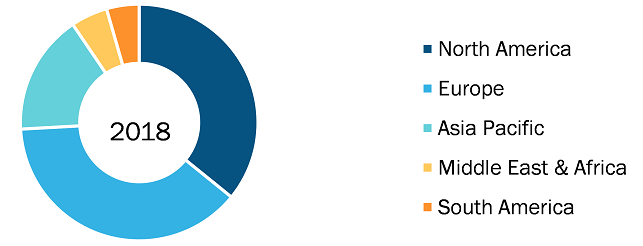According to the new research report published by The Insight Partners, titled “Robotic Refueling System Market - Global Analysis and Forecast to 2027”, the global robotic refueling system market is expected to reach US$ 194.0 Mn in 2027, registering a CAGR of 39.1% during the forecast period 2019-2027.
A robotic fueling system has the advantage of preventing human contact with potentially dangerous fumes, avoiding driver’s exposure to extreme hot or cold temperatures during fueling, and reducing the labor costs associated with full service fueling stations. A robotic fueling system consists of five main subsystems: control system which include user interface, processor, and logic schema; sensor system for vehicle positioning and identification, robotic arm, fuel dispensing nozzle, and the fuel port interface.
The main focus of robotic fuelling is to explore improvements over existing systems (manual) mainly by cost reduction (personnel cost) through automation. Simplification in robotic fueling can be achieved by the redesign of the vehicle positioning and fuel dispensing systems. The global robotic refueling system market has been witnessing robust growth due to factors such as Low cost of operation and flexibility of dispensing different fuels, adoption of this system by the mining industry owing to cost, flexibility, safety and increased productivity of mining operations. No requirement for operators on-site to man fuel stations and refuel vehicles is considered to the major driving factor for the robotic fueling systems remarkable growth rate during the forecast period from 2019 - 2027
Robotic Refueling System Market - Geographic Breakdown, 2018
Robotic Refueling System Market to 2027 - Global Analysis and Forecasts by Component (Hardware, Software); Fuel (Gaseous Fuel, Gasoline, Diesel, Others); Industry Vertical (Aerospace and Defense, Automotive, Construction, Oil and Gas, Mining, Others)
Robotic Refueling System Market Dynamics and Analysis - 2027
Download Free Sample
The robotic refueling system market has been derived from market trends and revenue generation factors from five different regions across the globe namely; North America, Europe, Asia Pacific, MEA, and SAM regions. The North America region holds the highest market share. Technological advancements in North America have led to a highly competitive market. It also attracts several technological developments, involving economically robust countries.
In recent times, vehicles entering a robotic refueling station are generally controlled by humans. Nonetheless, autonomous driving utilizing prescriptive or predictive analytics would leave human drivers redundant and make driving even more reasonable and safer operations. With the advent of autonomous vehicles, the vehicle would be directed by humans to enter a fuelling station. However, with the addition of artificial intelligence (AI) coupled with autonomous driving will extend beyond independent drive, and it will also aid in autonomous ongoing refueling operations, which will decipher the current issue of manually instructing the car for refueling and negate the need for human intervention. With the advent of level 5 autonomous vehicle coupled with AL, a vehicle on its own can enter a robotic fuel pump for refueling when the fuel level drops below the threshold level. Additionally, in the mining industry, autonomous trucks can stop at a containerized fuel station for the purpose of refueling without the intervention of human. Additionally, the concept of swarm intelligence (SI) is expected to allow the collaboration of multiple autonomous vehicles in the industry to take collective action of refueling when needed
The robotic refueling system market is segmented on the basis of fuel type into gaseous fuel, gasoline, diesel and others. The market based on component is segmented into hardware and software. Majority of vehicles running on the road are running mostly on gasoline owing to their less emission of exhaust gasses as compared to diesel. Thus gasoline held the highest market share in the year 2018 among the fuel type segment. Among the component segment, sub segment hardware segment include various sensors and systems such as vehicle positioning system, control system, robotic arm, fuel dispensing system and sensors such as position sensors and proximity. Hardware segment consists of more components which are much higher in price than the software segment. Thus, hardware held the largest market share in terms of revenue. Hardware also needs replacing in the event of damage or faulty operation, however, a software can be tweaked without incurring much cost.
The major companies operating in the market include Scott, KUKA, Fanuc, Fuelmatics, Neste, Rotec Engineering, Gazprom Neft, Mine Energy Solutions, Plug Power, Inc., and Shaw Development LLC among others.
The report segments the global robotic refueling system market as follows:
Global Robotic Refueling System market - By Component
- Hardware
- Software
Global Robotic Refueling System Market - By Fuel
- Gaseous Fuel
- Gasoline
- Diesel
- Others
Global Robotic Refueling System Market - By Industry Vertical
- Aerospace & Defense
- Automotive
- Construction
- Oil & Gas
- Mining
- Others
Global Robotic Refueling System market - By Geography
- North America
- U.S.
- Canada
- Mexico
- Europe
- France
- Germany
- UK
- Russia
- Italy
- Rest of Europe
- Asia Pacific (APAC)
- China
- India
- Japan
- Australia
- South Korea
- Rest of APAC
- Middle EAST & Africa (MEA)
- South Africa
- Saudi Arabia
- UAE
- Rest of MEA
- South America
- Brazil
- Argentina
- Rest of SAM
Contact Us
Phone: +1-646-491-9876
Email Id: sales@theinsightpartners.com